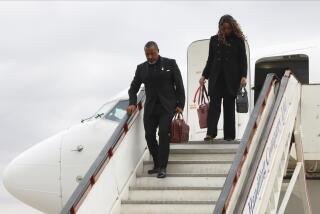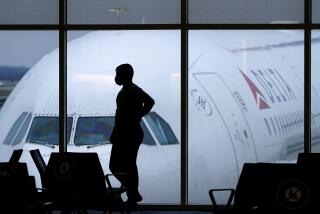Decade Fails to Solve Mystery of Italian Plane Disaster : Aviation: Questions persist about possible terrorism or a national cover-up in death of 81. Investigators suspect that air force officials manipulated evidence.
- Share via
ROME — Did a terrorist plant a bomb or did a missile go astray in an aerial dogfight? Was there a bungled investigation or an international cover-up of what caused the mysterious jetliner crash that killed 81 people?
Ten years after a DC-9 on a domestic flight blew apart in twilight skies and fell into the sea near the tiny island of Ustica, the questions remain unanswered.
Many theories have been advanced, but little information has been revealed. A complicating factor is judicial secrecy, which forbids disclosure until the investigation leads to indictments or closure of the case.
In May, an official panel of five experts who said in March, 1989, that a missile had struck the plane re-examined the evidence and split between missile and bomb.
Prime Minister Giulio Andreotti declared recently: “The more I read about it, the less I understand. It’s very disturbing, this interweaving of suspicions and rumors.”
A week earlier, state television reported that authorities ignored or forgot radar data from a station in Tuscany. The report interpreted the data as indicating that the DC-9, bound for Sicily, was caught in an engagement between French and Libyan jet fighters, but gave no proof.
It joined a multitude of sensational, unsubstantiated theories that have arisen over the years.
Some contended that a Libyan aircraft with Col. Moammar Kadafi aboard was above Sicily shortly before the crash.
One spoke of Kadafi’s favorite air force pilots chasing a defector across the skies; in another, U.S. jets fired a missile that hit the airliner by mistake.
French, U.S. and NATO officials have denied any military activity in the skies that night. Kadafi has blamed the United States, but offered no evidence.
Discovery of a crashed Libyan MIG fighter in the Calabrian mountains, almost due east of where the DC-9 went down, bolstered claims of a Libyan connection.
Doctors who performed an autopsy on the pilot first gave the date of death as July 18, then as late June, then switched back to the later date.
Investigators suspect air force officials of manipulating, hiding or destroying evidence and of lying about what happened that Friday when, 57 minutes into the flight and without a hint of trouble, the plane disappeared from radar screens while flying from Bologna to Palermo.
The DC-9 of Itavia, a small private carrier, carried 77 passengers, including 11 children and two infants, and a crew of four. School vacations had begun and many passengers were businessmen joining their families for the weekend.
Italy was plagued by terrorism in 1980 and and a bomb first seemed the likely cause. A few months after the crash, however, Transport Minister Rino Formica told Parliament that a missile was suspected.
In 1987, the government yielded to the outcries of relatives and engaged salvagers, who raised part of the wreckage.
Evidence studied by several official investigations indicated that the kind of explosive found in corpses and wreckage was used to make missiles. Examination of the fuselage indicated that the aircraft was struck from the outside, according to news reports.
Still, investigating commissions have differed. In May, 1989, two months after the commission report that a missile was to blame, another commission appointed by Ciriaco De Mita, then prime minister, decided that a bomb could not be ruled out.
This spring, when two members of the first commission reversed themselves and concluded that a bomb was responsible, an association of victims’ relatives, joined by some politicians, protested that the two had ties to a state-owned company involved in making missiles for the air force.
After the protest and the television report about the radar tapes, investigating magistrate Vincenzo Bucarelli announced that an October deadline to close the case would be lifted.
“Every time we got close to the truth, someone pushed us back, but I think we have finally succeeded in getting politicians” on our side, said Daria Bonfietti, who heads the association of victims’ relatives. Her brother, Alberto, was killed in the crash.
The Ustica mystery has been compared to other unsolved cases in Italy, including assassinations of Mafia investigators and terrorist bombings.
Corriere della Sera, a leading daily, said in an editorial:
“A country without truth. Evidently, around so many Italian mysteries, there’s an invincible force capable of confusing the ideas of experts, playing with the efforts of the magistrate’s office, mocking the appeals of the head of state. It’s this force, in reality, that struck the Itavia jet, massacring 81 people and the sense of justice.”
More to Read
Sign up for Essential California
The most important California stories and recommendations in your inbox every morning.
You may occasionally receive promotional content from the Los Angeles Times.










